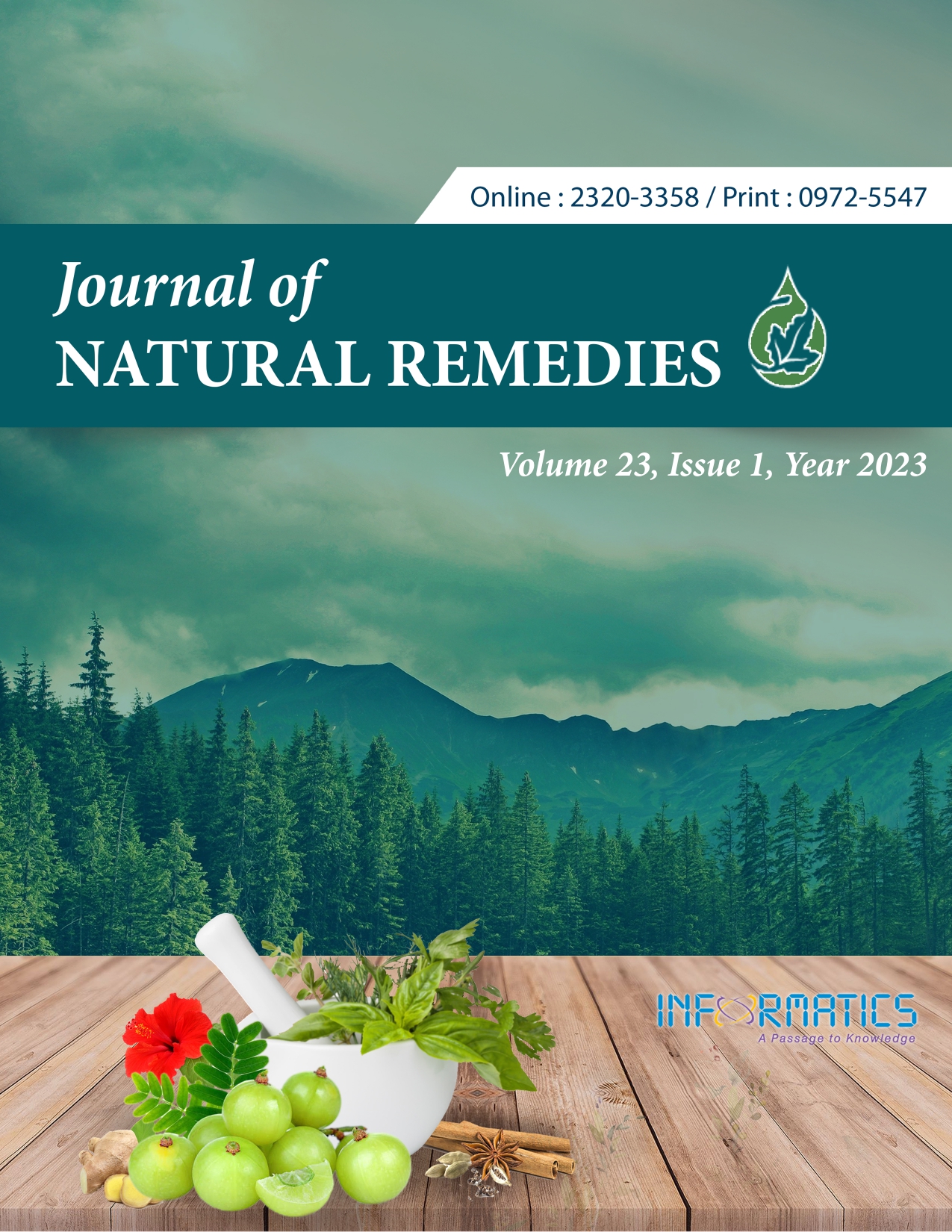Multi-Targeted Prediction of the Antiviral Effect of Momordica charantia extract based on Network Pharmacology
DOI:
https://doi.org/10.18311/jnr/2023/31430Keywords:
Antiviral, Hub Genes, LC-MS, Momordica charantia, Network Pharmacology, Pathway Analysis.Abstract
The fruits of Momordica charantia (Bitter Gourd) are well known for centuries as a natural remedy for the treatment of various ailments. In this study, we aimed to explore the metabolites present in both varieties of small and big bitter gourds and to explore the multitarget mechanism of M. charantia in antiviral infection by utilizing network pharmacology. The study design involves the identification of the compounds in both varieties of the bitter gourd by Agilent QTOFLC-MS/MS system, followed by screening for ADME to analyze the possible mechanism of action, disease association, protein-protein interactions and major pathways involved therein. Several Databases used were IMPAT, BindingDB, Swiss Target Prediction, STRING, DAVID, and KEGG databases, and algorithms were used to gather information. To visualize the network, Cytoscape 3.2.1 was used. As a result, a total of 22 and 27 compounds were detected from small and big bitter gourds respectively. . The molecules from M.charantia provide an antiviral response through the involvement of pathways like toll-like receptor pathway, PI3/AKT pathway, NF-kappa B signalling pathway, and cytokine-cytokine receptor interaction. Moreover, the core target genes termed ‘Hub Genes” were also identified through Cyto-hubba. The main mechanisms of M. charantia were acquired by investigating the enrichment of each cluster through functional association clustering analysis. Our results exposed the mechanism of M. charantia against viral infection by multi-component, multi-target, and multi-pathway study combinations.
Downloads
Metrics
Downloads
Published
How to Cite
Issue
Section
License
Copyright (c) 2023 Soma Das, Rahul Gajbhiye , Nitesh Kumar, Dhrubajyoti Sarkar (Author)

This work is licensed under a Creative Commons Attribution 4.0 International License.
Accepted 2023-01-09
Published 2023-03-23
References
Ben-Shabat S, Yarmolinsky L, Porat D, et al. Antiviral effect of phytochemicals from medicinal plants: Applications and drug delivery strategies. Drug Deliv Transl Res. 2020; 10(2):354-367. https://doi. org/10.1007/s13346-019-00691-6 DOI: https://doi.org/10.1007/s13346-019-00691-6
Abdel-Barry JA, Abdel-Hassan IA, Al-Hakiem MH. Hypoglycaemic and antihyperglycaemic effects of Trigonella foenum-graecum leaf in normal and alloxan induced diabetic rats. J Ethnopharmacol. 1997; 58(3):149-155. https://doi.org/10.1016/S0378- 8741(97)00101-3 DOI: https://doi.org/10.1016/S0378-8741(97)00101-3
Beloin N, Gbeassor M, Akpagana K, et al. Ethnomedicinal uses of Momordica charantia (Cucurbitaceae) in Togo and relation to its phytochemistry and biological activity. J Ethnopharmacol. 2005; 96(1-2):49-55. https://doi. org/10.1016/j.jep.2004.08.009 DOI: https://doi.org/10.1016/j.jep.2004.08.009
Zhang R, Zhu X, Bai H, et al. Network Pharmacology Databases for Traditional Chinese Medicine: Review and Assessment. Front Pharmacol. 2019; 10. https:// doi.org/10.3389/fphar.2019.00123 DOI: https://doi.org/10.3389/fphar.2019.00123
Yang Y, Yang K, Hao T, et al. Prediction of molecular mechanisms for lianxia ningxin formula: A network pharmacology study. Front Physiol. 2018; 9. https:// doi.org/10.3389/fphys.2018.00489 DOI: https://doi.org/10.3389/fphys.2018.00489
Hopkins AL. Network Pharmacology. Nat Biotechnol. 2007; 25(10):1110-1111. https://doi.org/10.1038/ nbt1007-1110 DOI: https://doi.org/10.1038/nbt1007-1110
Li S. Exploring traditional chinese medicine by a novel therapeutic concept of network target. Chin J Integr Med. 2016; 22(9):647-652. https://doi.org/10.1007/ s11655-016-2499-9 DOI: https://doi.org/10.1007/s11655-016-2499-9
Huang J, Li L, Cheung F, et al. Network Pharmacology Based Approach to Investigate the Analgesic Efficacy and Molecular Targets of Xuangui Dropping Pill for Treating Primary Dysmenorrhea. Evid Based Complement Alternat Med. 2017; 2017. https://doi. org/10.1155/2017/7525179 DOI: https://doi.org/10.1155/2017/7525179
Bader GD, Hogue CWV. An automated method for finding molecular complexes in large protein interaction networks. BMC Bioinformatics. 2003; 4. https://doi.org/10.1186/1471-2105-4-2 DOI: https://doi.org/10.1186/1471-2105-4-2
Rastogi R, Mehrotra B. Compendium of Indian medicinal plants. 1990.
Ru J, Li P, Wang J, et al. TCMSP: A database of systems pharmacology for drug discovery from herbal medicines. J Cheminformatics. 2014; 6(1). https:// doi.org/10.1186/1758-2946-6-13 DOI: https://doi.org/10.1186/1758-2946-6-13
Bateman A, Martin MJ, O’Donovan C, et al. UniProt: The universal protein knowledgebase. Nucleic Acids Res. 2017; 45(D1):D158-D169. https://doi. org/10.1093/nar/gkw1099 DOI: https://doi.org/10.1093/nar/gkw1099
Research UC-N acids, 2018 undefined. UniProt: the universal protein knowledge base. ncbi.nlm.nih.gov n.d.
Fishilevich S, Zimmerman S, Kohn A, et al. Genic insights from integrated human proteomics in GeneCards. academic.oup.com n.d.
Safran M, Dalah I, Alexander J, et al. GeneCards Version 3: the human gene integrator. Database J Biol Databases Curation. 2010; 2010. https://doi. org/10.1093/database/baq020 DOI: https://doi.org/10.1093/database/baq020
Cline MS, Smoot M, Cerami E, et al. Integration of biological networks and gene expression data using cytoscape. Nat Protoc. 2007; 2(10):2366-2382. https:// doi.org/10.1038/nprot.2007.324 DOI: https://doi.org/10.1038/nprot.2007.324
Maere S, Heymans K, Kuiper M. BiNGO: A Cytoscape plugin to assess over representation of Gene Ontology categories in Biological Networks. Bioinformatics. 2005; 21(16):3448-3449. https://doi.org/10.1093/ bioinformatics/bti551 DOI: https://doi.org/10.1093/bioinformatics/bti551
Szklarczyk D, Gable AL, Lyon D, et al. STRING v11: protein-protein association networks with increased coverage, supporting functional discovery in genome wide experimental datasets. Nucleic Acids Res. 2019; 47(D1):D607-D613. https://doi.org/10.1093/nar/ gky1131 DOI: https://doi.org/10.1093/nar/gky1131
Huang DW, Sherman BT, Lempicki RA. Systematic and integrative analysis of large gene lists using DAVID bioinformatics resources. Nat Protoc. 2009; 4(1):44-57. https://doi.org/10.1038/nprot.2008.211 DOI: https://doi.org/10.1038/nprot.2008.211
Shawky E. Prediction of potential cancer-related molecular targets of North African plants constituents using network pharmacology-based analysis. J Ethnopharmacol. 2019; 238:111826. https://doi. org/10.1016/j.jep.2019.111826 DOI: https://doi.org/10.1016/j.jep.2019.111826

 Soma Das
Soma Das









 0.35
0.35 24
24 0.161
0.161